oil temperature PONTIAC VIBE 2010 Owners Manual
[x] Cancel search | Manufacturer: PONTIAC, Model Year: 2010, Model line: VIBE, Model: PONTIAC VIBE 2010Pages: 318, PDF Size: 1.7 MB
Page 5 of 318
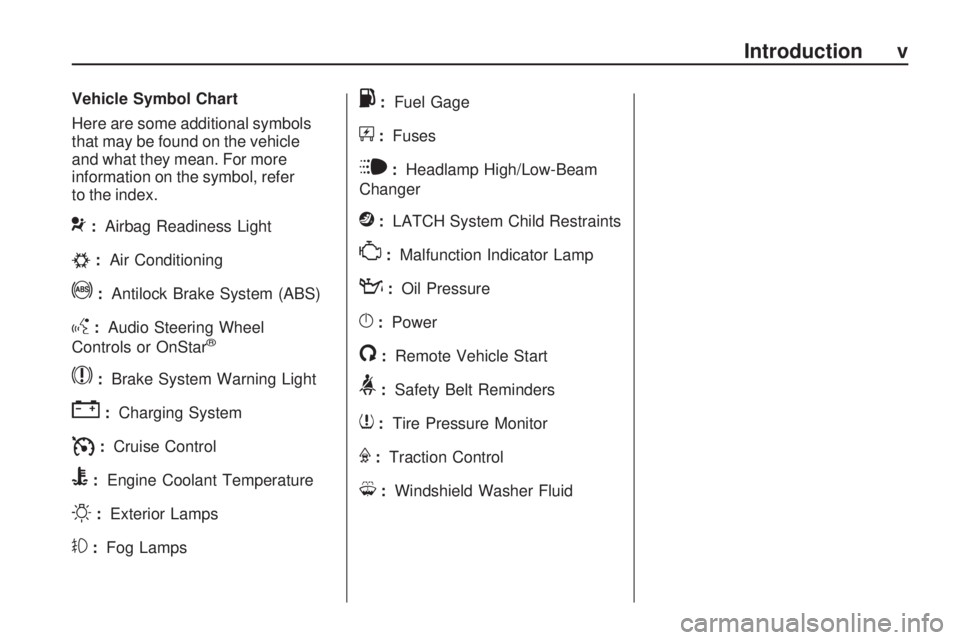
Vehicle Symbol Chart
Here are some additional symbols
that may be found on the vehicle
and what they mean. For more
information on the symbol, refer
to the index.
9:Airbag Readiness Light
#:Air Conditioning
!:Antilock Brake System (ABS)
g:Audio Steering Wheel
Controls or OnStar®
$: Brake System Warning Light
":Charging System
I:Cruise Control
B:Engine Coolant Temperature
O:Exterior Lamps
#:Fog Lamps
.:Fuel Gage
+:Fuses
i:Headlamp High/Low-Beam
Changer
j: LATCH System Child Restraints
*:Malfunction Indicator Lamp
::Oil Pressure
}:Power
/:Remote Vehicle Start
>:Safety Belt Reminders
7:Tire Pressure Monitor
F:Traction Control
M:Windshield Washer Fluid
Introduction v
Page 83 of 318

Instruments and
Controls
Instrument Panel OverviewInstrument Panel Overview.....4-2
ControlsSteering Wheel Adjustment.....4-4
Steering Wheel Controls .........4-4
Horn ...................................
.4-5
Windshield Wiper/Washer .......4-5
Rear Window Wiper/Washer . . . .4-6
Power Outlets (Accessory Power Outlets) ....................
.4-6
Power Outlets (115 Volt Alternating Current) .............
.4-7
Cigarette Lighter ..................
.4-8
Ashtrays .............................
.4-8
Warning Lights, Gages, and
Indicators
Warning Lights, Gages, and
Indicators ..........................
.4-8
Instrument Cluster ................
.4-9
Speedometer .....................
.4-10
Odometer ..........................
.4-10
Trip Odometer ....................
.4-10
Tachometer .......................
.4-10
Fuel Gage .........................
.4-10
Engine Coolant Temperature Gage .............4-11
Safety Belt Reminders ..........4-11
Airbag Readiness Light .........4-12
Passenger Airbag Status Indicator ..........................
.4-13
Charging System Light .........4-14
Malfunction Indicator Lamp .................
.4-14
Brake System Warning Light ...............................
.4-17
Antilock Brake System (ABS) Warning Light ...........4-17
Service All-Wheel Drive Light ...............................
.4-18Speed Sensitive Power
Steering (SSPS) Warning
Light ...............................
.4-18
StabiliTrak®Indicator Light . . . .4-18
Traction Control System (TCS) Warning Light ...........4-19
Tire Pressure Light .............
.4-19
Engine Oil Pressure Light .....4-19
Low Fuel Warning Light ........4-20
Security Light .....................
.4-20
High-Beam on Light .............4-20
Fog Lamp Light ..................
.4-20
Lamps on Reminder .............4-20
Taillamp Indicator Light .........4-21
Low Washer Fluid Warning Light ...............................
.4-21
Cruise Control Light .............4-21
Door Ajar Light ...................
.4-21
Vehicle PersonalizationVehicle Personalization .........4-21
OnStar SystemOnStar®System.................
.4-23
Instruments and Controls 4-1
Page 180 of 318
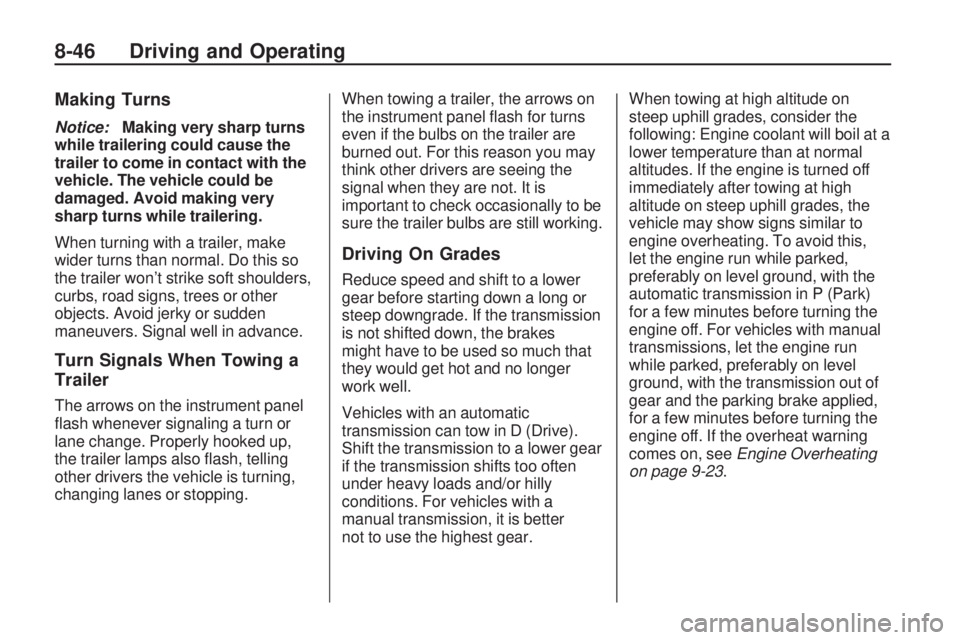
Making Turns
Notice:Making very sharp turns
while trailering could cause the
trailer to come in contact with the
vehicle. The vehicle could be
damaged. Avoid making very
sharp turns while trailering.
When turning with a trailer, make
wider turns than normal. Do this so
the trailer won’t strike soft shoulders,
curbs, road signs, trees or other
objects. Avoid jerky or sudden
maneuvers. Signal well in advance.
Turn Signals When Towing a
Trailer
The arrows on the instrument panel
flash whenever signaling a turn or
lane change. Properly hooked up,
the trailer lamps also flash, telling
other drivers the vehicle is turning,
changing lanes or stopping. When towing a trailer, the arrows on
the instrument panel flash for turns
even if the bulbs on the trailer are
burned out. For this reason you may
think other drivers are seeing the
signal when they are not. It is
important to check occasionally to be
sure the trailer bulbs are still working.
Driving On Grades
Reduce speed and shift to a lower
gear before starting down a long or
steep downgrade. If the transmission
is not shifted down, the brakes
might have to be used so much that
they would get hot and no longer
work well.
Vehicles with an automatic
transmission can tow in D (Drive).
Shift the transmission to a lower gear
if the transmission shifts too often
under heavy loads and/or hilly
conditions. For vehicles with a
manual transmission, it is better
not to use the highest gear.When towing at high altitude on
steep uphill grades, consider the
following: Engine coolant will boil at a
lower temperature than at normal
altitudes. If the engine is turned off
immediately after towing at high
altitude on steep uphill grades, the
vehicle may show signs similar to
engine overheating. To avoid this,
let the engine run while parked,
preferably on level ground, with the
automatic transmission in P (Park)
for a few minutes before turning the
engine off. For vehicles with manual
transmissions, let the engine run
while parked, preferably on level
ground, with the transmission out of
gear and the parking brake applied,
for a few minutes before turning the
engine off. If the overheat warning
comes on, see
Engine Overheating
on page 9-23.
8-46 Driving and Operating
Page 195 of 318
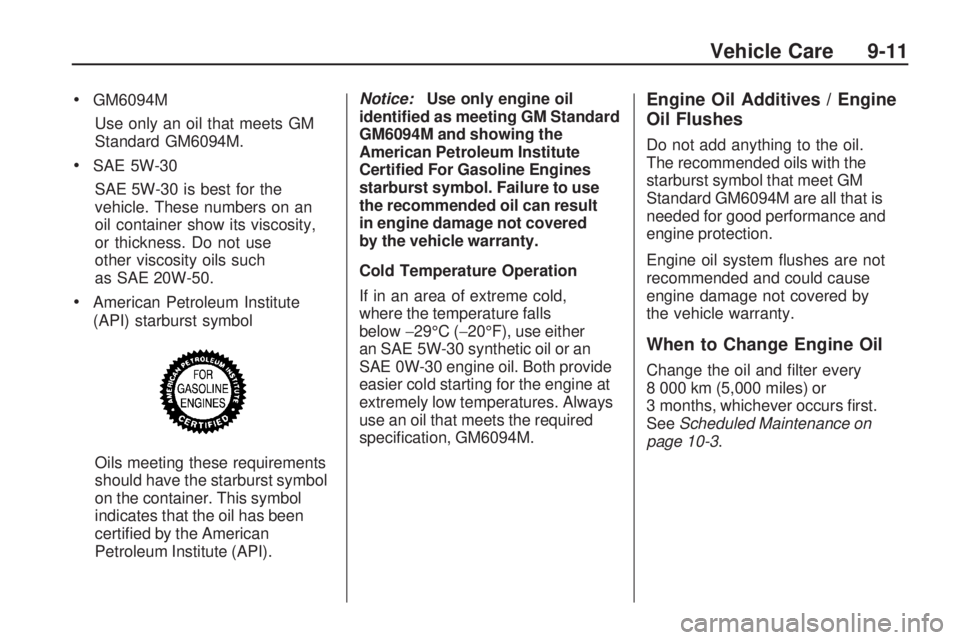
•GM6094MUse only an oil that meets GM
Standard GM6094M.
•SAE 5W-30SAE 5W-30 is best for the
vehicle. These numbers on an
oil container show its viscosity,
or thickness. Do not use
other viscosity oils such
as SAE 20W-50.
•American Petroleum Institute
(API) starburst symbol
Oils meeting these requirements
should have the starburst symbol
on the container. This symbol
indicates that the oil has been
certified by the American
Petroleum Institute (API). Notice:
Use only engine oil
identi�ed as meeting GM Standard
GM6094M and showing the
American Petroleum Institute
Certi�ed For Gasoline Engines
starburst symbol. Failure to use
the recommended oil can result
in engine damage not covered
by the vehicle warranty.
Cold Temperature Operation
If in an area of extreme cold,
where the temperature falls
below −29°C (−20°F), use either
an SAE 5W-30 synthetic oil or an
SAE 0W-30 engine oil. Both provide
easier cold starting for the engine at
extremely low temperatures. Always
use an oil that meets the required
specification, GM6094M.
Engine Oil Additives / Engine
Oil Flushes
Do not add anything to the oil.
The recommended oils with the
starburst symbol that meet GM
Standard GM6094M are all that is
needed for good performance and
engine protection.
Engine oil system flushes are not
recommended and could cause
engine damage not covered by
the vehicle warranty.
When to Change Engine Oil
Change the oil and filter every
8 000 km (5,000 miles) or
3 months, whichever occurs first.
See Scheduled Maintenance on
page 10-3.
Vehicle Care 9-11
Page 196 of 318
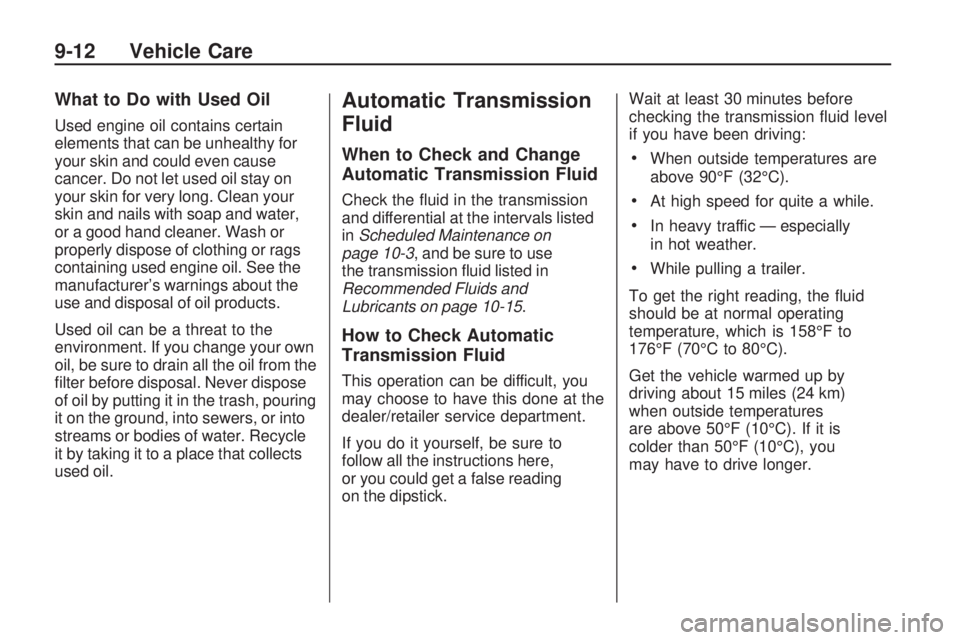
What to Do with Used Oil
Used engine oil contains certain
elements that can be unhealthy for
your skin and could even cause
cancer. Do not let used oil stay on
your skin for very long. Clean your
skin and nails with soap and water,
or a good hand cleaner. Wash or
properly dispose of clothing or rags
containing used engine oil. See the
manufacturer’s warnings about the
use and disposal of oil products.
Used oil can be a threat to the
environment. If you change your own
oil, be sure to drain all the oil from the
filter before disposal. Never dispose
of oil by putting it in the trash, pouring
it on the ground, into sewers, or into
streams or bodies of water. Recycle
it by taking it to a place that collects
used oil.
Automatic Transmission
Fluid
When to Check and Change
Automatic Transmission Fluid
Check the fluid in the transmission
and differential at the intervals listed
inScheduled Maintenance on
page 10-3, and be sure to use
the transmission fluid listed in
Recommended Fluids and
Lubricants on page 10-15 .
How to Check Automatic
Transmission Fluid
This operation can be difficult, you
may choose to have this done at the
dealer/retailer service department.
If you do it yourself, be sure to
follow all the instructions here,
or you could get a false reading
on the dipstick. Wait at least 30 minutes before
checking the transmission fluid level
if you have been driving:
•When outside temperatures are
above 90°F (32°C).
•At high speed for quite a while.
•In heavy traffic — especially
in hot weather.
•While pulling a trailer.
To get the right reading, the fluid
should be at normal operating
temperature, which is 158°F to
176°F (70°C to 80°C).
Get the vehicle warmed up by
driving about 15 miles (24 km)
when outside temperatures
are above 50°F (10°C). If it is
colder than 50°F (10°C), you
may have to drive longer.
9-12 Vehicle Care
Page 204 of 318
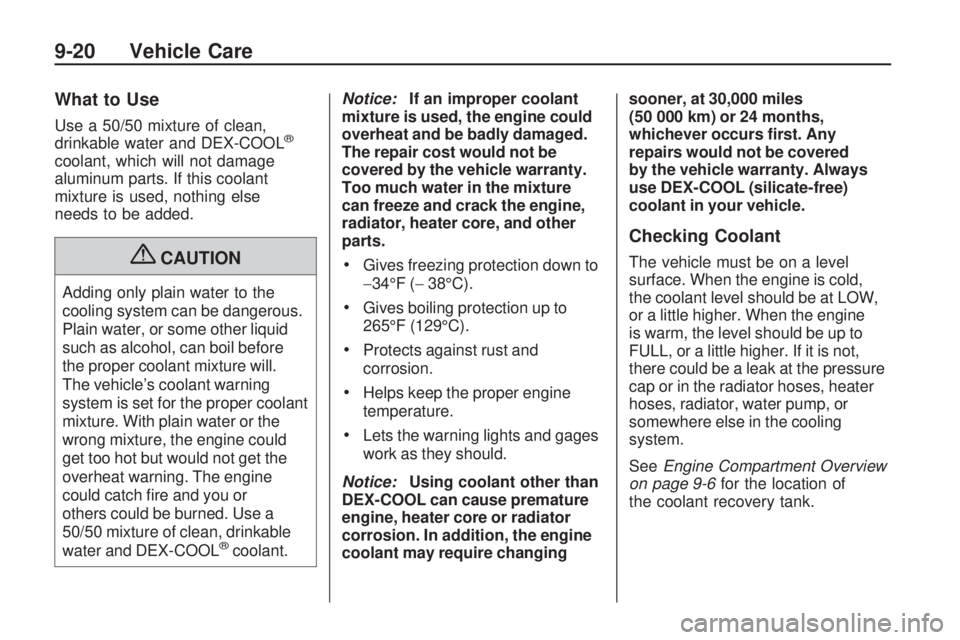
What to Use
Use a 50/50 mixture of clean,
drinkable water and DEX-COOL®
coolant, which will not damage
aluminum parts. If this coolant
mixture is used, nothing else
needs to be added.
{CAUTION
Adding only plain water to the
cooling system can be dangerous.
Plain water, or some other liquid
such as alcohol, can boil before
the proper coolant mixture will.
The vehicle’s coolant warning
system is set for the proper coolant
mixture. With plain water or the
wrong mixture, the engine could
get too hot but would not get the
overheat warning. The engine
could catch fire and you or
others could be burned. Use a
50/50 mixture of clean, drinkable
water and DEX-COOL
®coolant.Notice:
If an improper coolant
mixture is used, the engine could
overheat and be badly damaged.
The repair cost would not be
covered by the vehicle warranty.
Too much water in the mixture
can freeze and crack the engine,
radiator, heater core, and other
parts.
•Gives freezing protection down to
−34°F (− 38°C).
•Gives boiling protection up to
265°F (129°C).
•Protects against rust and
corrosion.
•Helps keep the proper engine
temperature.
•Lets the warning lights and gages
work as they should.
Notice: Using coolant other than
DEX-COOL can cause premature
engine, heater core or radiator
corrosion. In addition, the engine
coolant may require changing sooner, at 30,000 miles
(50 000 km) or 24 months,
whichever occurs �rst. Any
repairs would not be covered
by the vehicle warranty. Always
use DEX-COOL (silicate-free)
coolant in your vehicle.
Checking Coolant
The vehicle must be on a level
surface. When the engine is cold,
the coolant level should be at LOW,
or a little higher. When the engine
is warm, the level should be up to
FULL, or a little higher. If it is not,
there could be a leak at the pressure
cap or in the radiator hoses, heater
hoses, radiator, water pump, or
somewhere else in the cooling
system.
See
Engine Compartment Overview
on page 9-6 for the location of
the coolant recovery tank.
9-20 Vehicle Care
Page 207 of 318
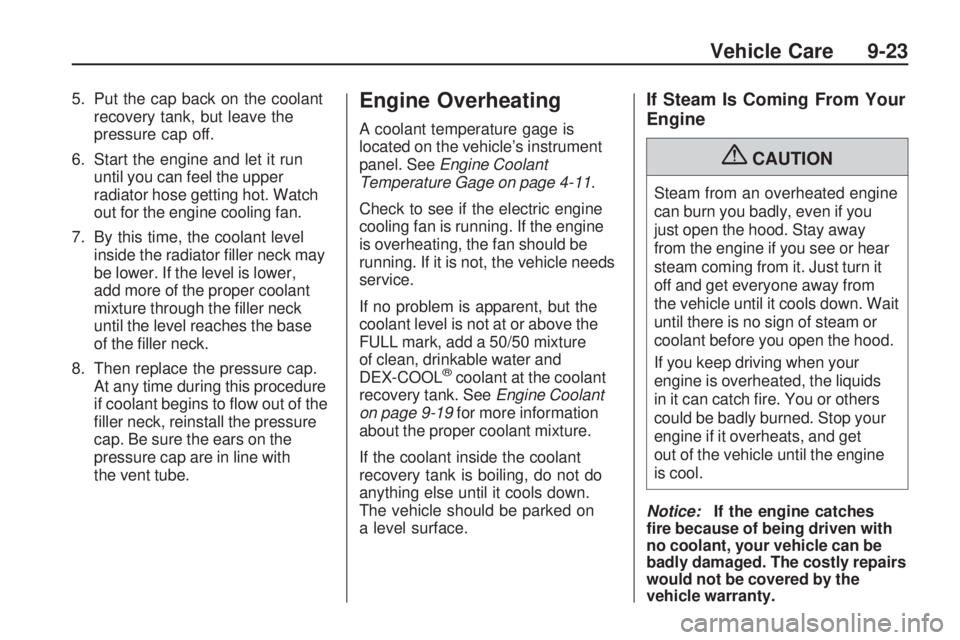
5. Put the cap back on the coolantrecovery tank, but leave the
pressure cap off.
6. Start the engine and let it run until you can feel the upper
radiator hose getting hot. Watch
out for the engine cooling fan.
7. By this time, the coolant level inside the radiator filler neck may
be lower. If the level is lower,
add more of the proper coolant
mixture through the filler neck
until the level reaches the base
of the filler neck.
8. Then replace the pressure cap. At any time during this procedure
if coolant begins to flow out of the
filler neck, reinstall the pressure
cap. Be sure the ears on the
pressure cap are in line with
the vent tube.Engine Overheating
A coolant temperature gage is
located on the vehicle’s instrument
panel. See Engine Coolant
Temperature Gage on page 4-11 .
Check to see if the electric engine
cooling fan is running. If the engine
is overheating, the fan should be
running. If it is not, the vehicle needs
service.
If no problem is apparent, but the
coolant level is not at or above the
FULL mark, add a 50/50 mixture
of clean, drinkable water and
DEX-COOL
®coolant at the coolant
recovery tank. See Engine Coolant
on page 9-19 for more information
about the proper coolant mixture.
If the coolant inside the coolant
recovery tank is boiling, do not do
anything else until it cools down.
The vehicle should be parked on
a level surface.
If Steam Is Coming From Your
Engine
{CAUTION
Steam from an overheated engine
can burn you badly, even if you
just open the hood. Stay away
from the engine if you see or hear
steam coming from it. Just turn it
off and get everyone away from
the vehicle until it cools down. Wait
until there is no sign of steam or
coolant before you open the hood.
If you keep driving when your
engine is overheated, the liquids
in it can catch fire. You or others
could be badly burned. Stop your
engine if it overheats, and get
out of the vehicle until the engine
is cool.
Notice: If the engine catches
�re because of being driven with
no coolant, your vehicle can be
badly damaged. The costly repairs
would not be covered by the
vehicle warranty.
Vehicle Care 9-23
Page 274 of 318
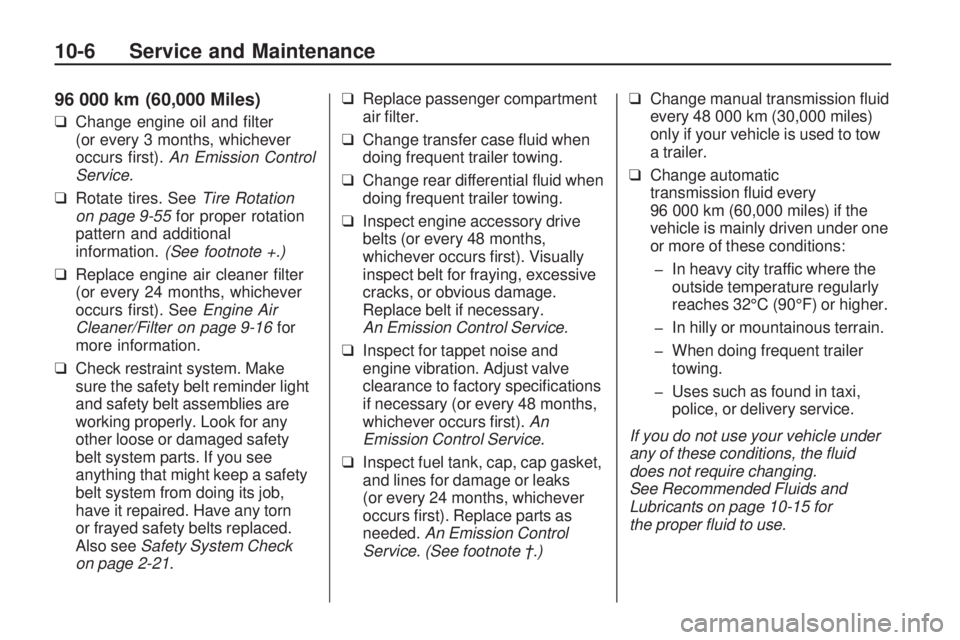
96 000 km (60,000 Miles)
❑Change engine oil and filter
(or every 3 months, whichever
occurs first). An Emission Control
Service.
❑ Rotate tires. See Tire Rotation
on page 9-55 for proper rotation
pattern and additional
information. (See footnote +.)
❑ Replace engine air cleaner filter
(or every 24 months, whichever
occurs first). See Engine Air
Cleaner/Filter on page 9-16 for
more information.
❑ Check restraint system. Make
sure the safety belt reminder light
and safety belt assemblies are
working properly. Look for any
other loose or damaged safety
belt system parts. If you see
anything that might keep a safety
belt system from doing its job,
have it repaired. Have any torn
or frayed safety belts replaced.
Also see Safety System Check
on page 2-21. ❑
Replace passenger compartment
air filter.
❑ Change transfer case fluid when
doing frequent trailer towing.
❑ Change rear differential fluid when
doing frequent trailer towing.
❑ Inspect engine accessory drive
belts (or every 48 months,
whichever occurs first). Visually
inspect belt for fraying, excessive
cracks, or obvious damage.
Replace belt if necessary.
An Emission Control Service.
❑ Inspect for tappet noise and
engine vibration. Adjust valve
clearance to factory specifications
if necessary (or every 48 months,
whichever occurs first). An
Emission Control Service.
❑ Inspect fuel tank, cap, cap gasket,
and lines for damage or leaks
(or every 24 months, whichever
occurs first). Replace parts as
needed. An Emission Control
Service. (See footnote †.) ❑
Change manual transmission fluid
every 48 000 km (30,000 miles)
only if your vehicle is used to tow
a trailer.
❑ Change automatic
transmission fluid every
96 000 km (60,000 miles) if the
vehicle is mainly driven under one
or more of these conditions:
- In heavy city traffic where the outside temperature regularly
reaches 32°C (90°F) or higher.
- In hilly or mountainous terrain.
- When doing frequent trailer towing.
- Uses such as found in taxi, police, or delivery service.
If you do not use your vehicle under
any of these conditions, the �uid
does not require changing.
See Recommended Fluids and
Lubricants on page 10-15 for
the proper �uid to use.
10-6 Service and Maintenance
Page 311 of 318

CoversCargo ............................... 3-2
Cruise Control ..................... 8-36
Light ............................... 4-21
Cupholders ........................... 3-1
Customer Assistance ............12-4
Offices ............................ 12-3
Text Telephone (TTY) Users .......................... 12-4
Customer Information Service PublicationsOrdering Information .....12-12
Customer Satisfaction Procedure ........................ 12-1
D
Damage Repair, Collision ....12-10
Danger, Warnings, and Cautions .............................. iii
Data Recorders Event ............................ 12-14
Daytime Running Lamps (DRL) ..................... 5-2 Defensive Driving
................... 8-2
Devices, Auxiliary .................6-14
Dome Lamps ........................ 5-4
Door Ajar Light ........................ 4-21
Locks ............................... 1-5
Power Locks ...................... 1-6
Drive Systems All-Wheel Drive ........8-31, 9-29
Driving Better Fuel Economy .......... 8-2
Characteristics and Towing Tips .................. 8-44
Defensive .......................... 8-2
Drunk ............................... 8-3
Highway Hypnosis .............. 8-8
Hill and Mountain Roads ..... 8-8
If the Vehicle is Stuck .......8-11
Loss of Control .................. 8-6
Off-Road Recovery ............. 8-6
Vehicle Load Limits ...........8-12
Winter .............................. 8-9
E
Electrical Equipment
Add-On Equipment ............8-50
Electrical System Engine Compartment FuseBlock ........................... 9-38
Fuses and Circuit Breakers ...................... 9-38
Instrument Panel Fuse Block ........................... 9-41
Overload ......................... 9-37
Engine Air Cleaner/Filter ...............9-16
Check and Service Engine Soon Lamp .................. 4-14
Compartment Overview ....... 9-6
Coolant ........................... 9-19
Coolant Temperature Gage .........4-11
Cooling System ................9-19
Drive Belt Routing .............11-4
Exhaust ........................... 8-23
Oil ................................... 9-9
Overheating ..................... 9-23
INDEX i-3